Red potato varieties (with pink or red peel, eyes): descriptions and characteristics
It is believed that the brighter and darker the color of the tubers, or rather the pulp, the healthier the potatoes, because it contains more vitamins and antioxidants. Therefore, many people believe that potatoes with red peel are the most useful, but this is not entirely true ... The most useful is considered to be colored potatoes, which have red or purple not only the peel, but also the pulp. However, it is quite rare, so its alternative would be red varieties (with red peel) and yellow pulp, which contain a lot of vitamin A (carotene), although from white varieties do not give up, they have their own advantages.
Next, we suggest you familiarize yourself with the best and most popular varieties of red potatoes, so that you can better decide on the choice for buying and / or planting seed tubers in your summer cottage.
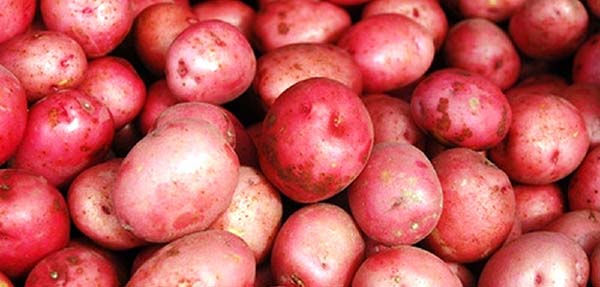
Note! In this review article, we will focus on red potato varieties, in which the peel is pink or red, or only the eyes. The pulp can be either white or cream, beige, yellow or even purple (unfortunately, such varieties have not yet been bred).
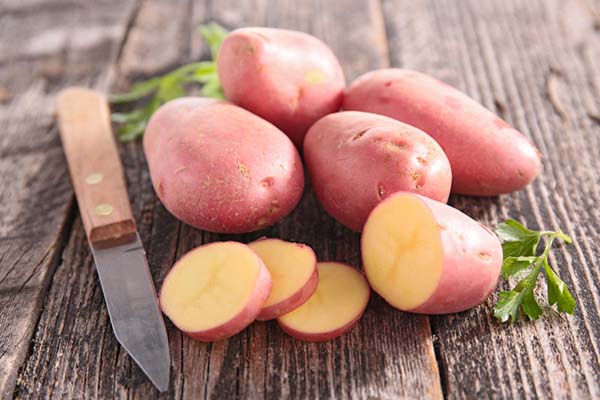
Content
The best red potatoes (with red or pink skin): top 15
Interesting! It is believed (partly justified) that potatoes with red peels keep their shape perfectly, which means it is ideal more for frying, yellow -for soups and salads(although for soups and frying, potatoes should not be boiled in the first place), and white -for making puree. But in fact, many other white and red (pink) and purple varieties are suitable for frying and soups. The bottom line is that it is the percentage of starch that determines the taste and culinary purpose of potatoes. In white varieties (with white pulp), starch is usually more (but not always), so it boils down more (not suitable for frying, as well as for making soups and salads).
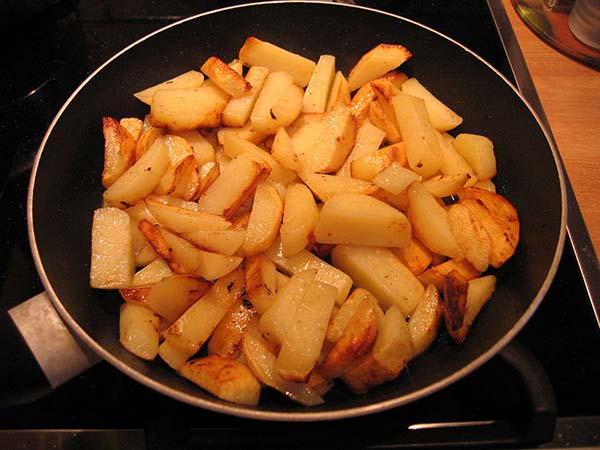
So, the best and most popular red potatoes (with pink or red skin) are:
Alyona
An early variety with good yield and taste.
The variety has a stable yield, a consistent return of early production, drought tolerance and suitability for mechanized cultivation technology.
Responds very well to germination.
Resistant to the causative agent of potato cancer, susceptible to nematode. Susceptible to late blight. Resistant to common scab, rhizoctonia.
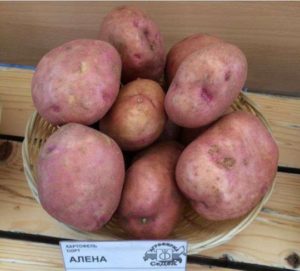
The taste is good. Culinary type VS. The digestibility is moderate. The pulp does not darken. Suitable for purees, soups, salads and frying. Suitable for making crispy potatoes and French fries.
Characteristics of the Alena variety:
- ripening period - early (70-80 days);
- tubers are oval;
- the structure of the peel is smooth;
- peel color - red;
- the color of the pulp is white;
- the depth of the eyes is shallow;
- starch content - 15-17%;
- yield per hundred square meters - 172-292 kg (maximum up to 391 kg);
- the number of tubers per bush - 6-10;
- the average weight of 1 tuber is 86-167 g;
- marketability - 81-97%;
- keeping quality - 95%.
The appearance of the plant - bushes of medium height, intermediate type, spreading. The leaf is large, wide, green. No or very slight waviness in the edge. Inflorescences are medium in size, reddish-purple. Berry formation is very rare.
Recommended for planting regions: Volgo-Vyatka, Ural, West Siberian, East Siberian, Far East.
Patent holder and / or originator of the variety: Federal State Budgetary Scientific Institution "Omsk ANC" (Russia).
Bellarosa (Bella Rose or White Rose)
Early ripening variety with good yield and taste.
Interesting! Due to the specific bright red color of the peel in Russian-speaking countries, it received a popular name - Cherry potatoes.
The variety is not picky about moisture and perfectly tolerates hot periods without loss of fruit quality. Any type of soil is suitable except for heavy loamy soil.
Advice! It is advisable to germinate before planting. Positively responds to fertilization.
In most cases, it manages to bloom by the time a massive amount of the Colorado potato beetle appears. Also, the variety is resistant to the causative agent of potato cancer and nematode. It tolerates transportation well.
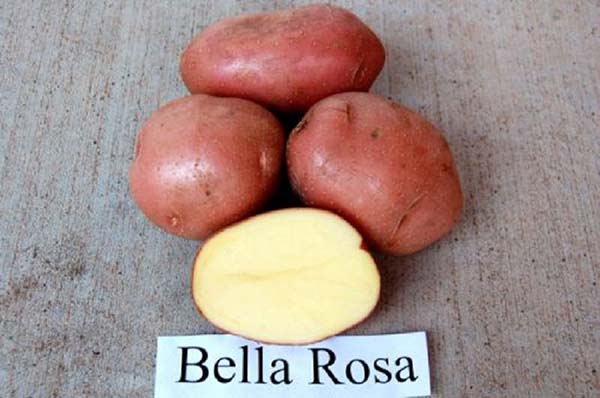
The taste is good. It does not boil during cooking. Suitable for frying and preparing soups and salads.
Young potatoes can be dug in on the 45th day after germination.
Characteristics of the Bellarosa variety:
- ripening period - early (70-80 days);
- the shape of the tubers is oval-round;
- the structure of the peel is rough;
- peel color - red;
- pulp color - light yellow;
- the depth of the eyes is shallow or medium;
- starch content - 12.6-15.7%
- yield per hundred square meters - 169-326 kg (maximum up to 385 kg);
- the number of tubers per bush - 8-9;
- the average weight of 1 tuber is 117-207 g;
- marketability - 82-99%;
- keeping quality - 93%.
The appearance of the plant - forms tall erect shoots, with large green leaves. The inflorescences are medium and have a red-purple hue.
Regions recommended for planting: North-West, Volgo-Vyatsky, Central Black Earth Region, Uralsky.
Patent holder and / or originator of the variety: Europlant Pflanzenzucht GmbH (Germany).
Vector
Mid-season variety, good yield and taste.
Not picky about the composition of the soil, but can achieve maximum performance when grown on sod-podzolic and peat-bog soils. It tolerates heat well.
Resistant to the causative agent of potato cancer, susceptible to nematode. Highly resistant to late blight pathogen in tops and tubers, resistant to wrinkled, banded mosaics and leaf curling. The tubers have a dense skin that is resistant to mechanical damage during transportation.
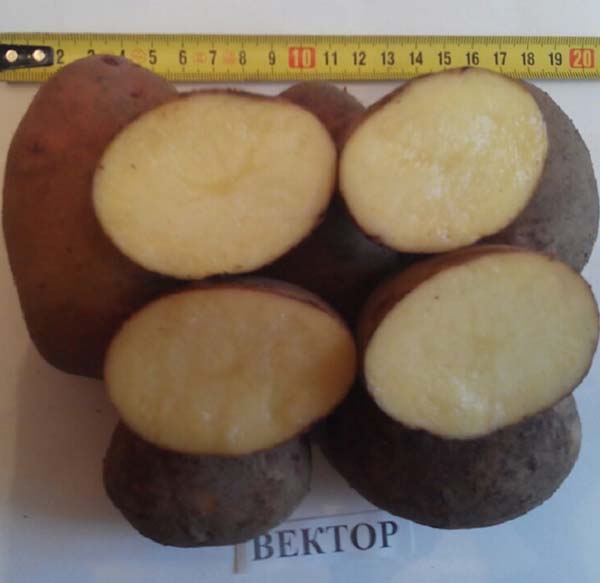
Taste good or great. Culinary type VS. The digestibility is average. The pulp does not darken during cooking. The variety is suitable for the production of starch, chips and purees.
Characteristics of the Vector variety:
- ripening period - mid-season (90-110);
- the shape of the tubers is oval-round;
- the structure of the peel is smooth;
- peel color - red;
- pulp color - light yellow;
- the depth of the eyes is shallow;
- starch content - 16.7-17.5%;
- yield per one hundred square meters - 180-263 kg (maximum up to 403 kg);
- the number of tubers per bush - 10-14;
- the average weight of 1 tuber is 92-143 g.
- marketability - 90-98%;
- keeping quality - 95%.
The appearance of the plant is low, leaf type, semi-erect. The leaf is small, intermediate, dark green. The inflorescences are purple.
Recommended landing regions: Central.
Patent holder and / or originator of the variety: FGBNU “All-Russian Research Institute of Potato Farming named after A.G. Lorkha (Russia).
Zhukovsky early
Early variety, high yield and medium flavor.
It perfectly adapts to changing climatic conditions, is relatively heat and drought resistant. The yield is stable.
Important! Zhukovsky grows amicably even in poorly warmed soil, so the variety can be safely planted at the end of April.
Resistant to potato crayfish and nematodes. Susceptible to tops and tubers to the causative agent of late blight. The tubers are resistant to mechanical damage.
The taste is satisfactory and good. Culinary type B. Boiled weak. During the cooking process, the pulp darkens slightly. Great for frying, soups, salads, fries and chips. Can be used for puree and cooking, but not very suitable.
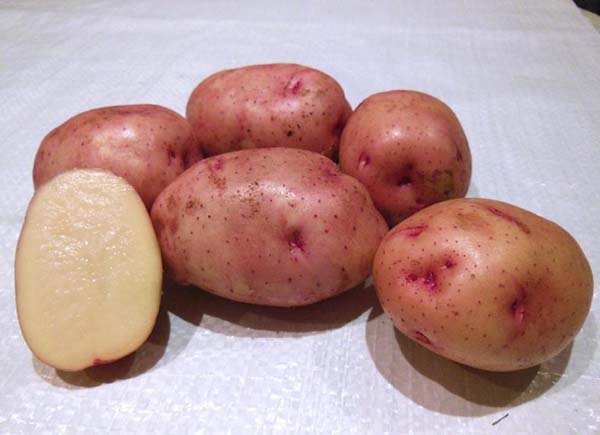
Characteristics of the early Zhukovsky variety:
- ripening period - early (70-80 days), according to other sources, very early (60-80 days);
- the tubers are oval-round;
- the structure of the peel is smooth;
- peel color - pink;
- the color of the pulp is white;
- the depth of the eyes is shallow;
- starch content - 10-12%;
- yield per one hundred square meters - 400-450 kg;
- the number of tubers per bush - 9-15;
- the average weight of 1 tuber is 100-120 g;
- marketability - 90-92%;
- keeping quality is good.
Appearance - bushes of medium height, semi-spreading stem type, the leaf is small, green (glossy), the flowers have a red-violet hue. Berry formation is rare.
Recommended for planting regions: North-West, Central, Volgo-Vyatka, Central black earth, North Caucasian, Middle Volga, Nizhnevolzhsky, Ural, West Siberian, Far East.
Patent holder and / or originator of the variety: FGBNU “All-Russian Research Institute of Potato Farming named after A.G. Lorkha (Russia).
Zhuravinka
Medium late variety, medium yield and good taste.
Suitable for growing on light to medium-sized soils. Does not tolerate waterlogging of the soil or moisture deficit during the growing season. It reacts negatively to excessive application of nitrogen to the soil, but is very responsive to the application of organic and mineral fertilizers.
Resistant to the causative agent of potato cancer, nematode and common scab. Moderately susceptible to late blight and rhizoctonia. Moderately resistant to mechanical damage.
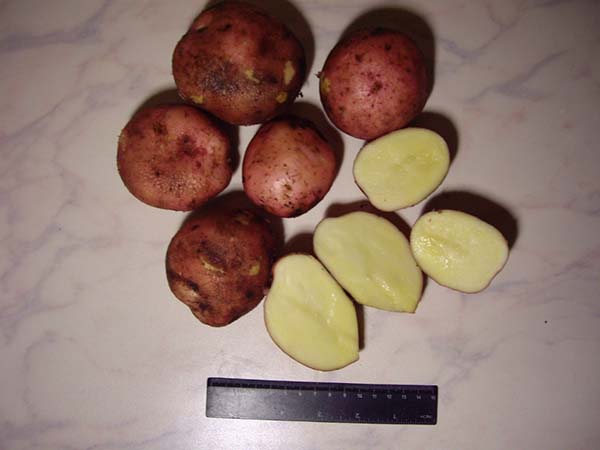
The taste is good. Culinary type VS. The pulp is boiled softly (medium). Does not darken during cooking. Good for mashed potatoes and baked. It is also recommended for making chips, fries and starch.
Characteristics of the Zhuravinka variety:
- ripening period - medium late (110-120 days);
- the shape of the tubers is oval-round;
- the structure of the peel is slightly rough (rather smooth);
- peel color - red;
- pulp color - light yellow;
- the depth of the eyes is shallow;
- starch content - 14.6-19.6%;
- yield per one hundred square meters - 177-242 kg.
- the number of tubers per bush - up to 18;
- the average weight of 1 tuber is 89-139 g;
- marketability - 83-96%;
- keeping quality - 93%.
The appearance of the plant is of medium height, intermediate type, semi-erect. The leaf is small, intermediate, dark green. The waviness of the edge is weak. Inflorescences are medium in size, reddish-purple. The berries are practically not formed (rarely).
Recommended for planting regions: North-West, Central, Volgo-Vyatka.
Patent holder and / or originator of the variety: RUE "Scientific and Production Center of the National Academy of Sciences of Belarus for Potato and Fruit Growing" (Belarus).
Kamensky
Early maturing variety, medium yield and good taste.
It is characterized by early yield accumulation and leveled tubers with high marketability.
It adapts well to all types of soil. Differs in drought resistance due to the early formation of tubers. Requires loosening of the soil, responds positively to fertilization and watering. The tough leaves of adult plants do not like the Colorado potato beetle.
Resistant to the causative agent of potato cancer. Susceptible to nematode. Medium resistant to late blight pathogen, resistant to wrinkled and banded mosaics, leaf twisting, common scab and rhizoctonia.
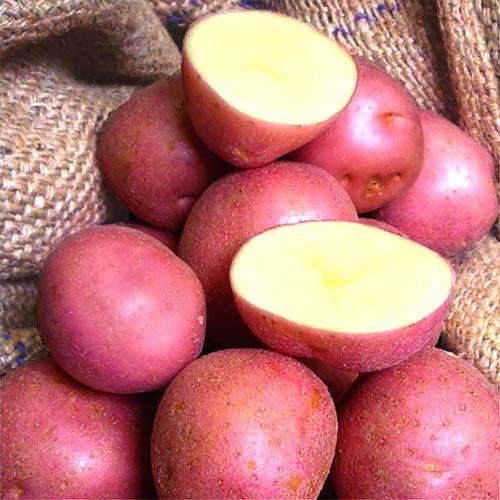
The taste is good. Culinary type B (poor digestibility). Suitable for first courses (soups), salads and frying.
Characteristics of the Kamensky variety:
- ripening period - early (70-80 days);
- the shape of the tubers is elongated-oval;
- the structure of the peel is smooth;
- peel color - red;
- pulp color - light yellow;
- the depth of the eyes is shallow;
- starch content - 12.2-16.8%;
- yield per hundred square meters - 185 kg (maximum up to 252 kg);
- the number of tubers per bush - 15-25;
- the average weight of 1 tuber is 96-108 g;
- marketability - 85-94%;
- keeping quality - 97%.
The appearance of the plant is of an intermediate type, semi-erect. Medium leaf, intermediate type, dark green. Strong edge waviness. The intensity of the anthocyanin coloration of the inner side of the corolla is from medium to strong, the proportion of blue is absent or very small. The inflorescences are large. and red and purple. Berry formation is rare.
Recommended for planting regions: Volgo-Vyatka, Ural, West Siberian.
Patentee and / or originator of the variety: FGBNU "Ural Research Institute of Agriculture" (Russia).
Labella
Early variety, medium yield, excellent taste.
Resistant to high temperatures during the growing season, has excellent adaptability to climatic conditions and soil types.
Resistant to the causative agent of potato cancer and nematodes. Highly resistant to leaf roll virus.
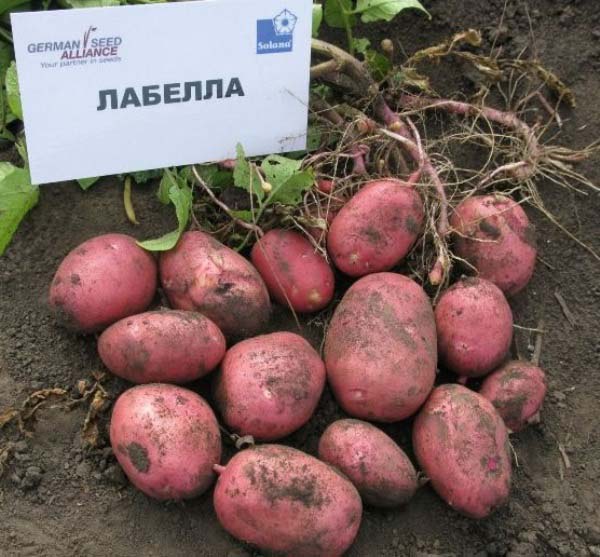
The taste is excellent. The digestibility is average. Therefore, you can even boil it, even fry it, even bake it in the oven or make mashed potatoes.
Characteristics of the Labella variety:
- ripening period - early (70-80 days);
- the shape of the tubers is elongated-oval;
- the structure of the peel is smooth;
- peel color - red;
- the color of the pulp is yellow;
- the depth of the eyes is from shallow to medium;
- starch content - 15.8%;
- yield per hundred square meters - 176-264 kg (maximum up to 342 kg);
- the number of tubers per bush - up to 14;
- the average weight of 1 tuber is 78-102 g;
- marketability - 91-92%;
- keeping quality - 98%.
The appearance of the plant is from medium height to tall, leaf type, semi-erect. The leaf is large, intermediate, green.Inflorescences are red-purple.
Recommended for planting regions: Central, North Caucasian, Middle Volga, Ural.
Patent holder and / or originator of the variety: Den Hartigh BV (Holland).
Lyubava
Early variety, high yield, good taste. Culinary type A (salad type). Does not boil over. The pulp darkens moderately during cooking.
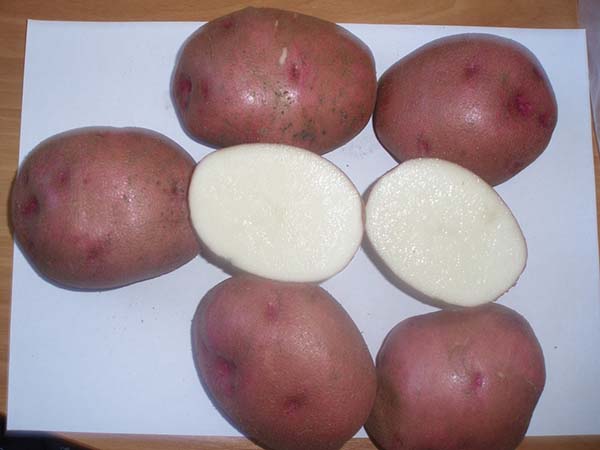
Resistant to the causative agent of potato cancer, rhizoctonia, susceptible to nematode. It is also susceptible in terms of tops and moderately resistant in tubers to the causative agent of late blight. Moderately resistant to common scab.
Characteristics of the Lyubava variety:
- ripening period - early (70-80 days);
- the shape of the tubers is oval-round;
- the structure of the peel is from medium to coarse (according to other sources, it is generally suitable, but flaky at the top);
- peel color - red;
- the color of the pulp is white;
- the depth of the eyes is average;
- starch content - 11.2-16.9%;
- yield per hundred square meters - 288-400 kg (maximum up to 524 kg);
- the number of tubers per bush - 8-15;
- the average weight of 1 tuber is 109-210 g;
- marketability - 80-98%;
- keeping quality is good.
The appearance of the bushes is of medium height, intermediate type, semi-erect. The leaf is small, open, light green. The waviness of the edge is weak. Average gloss. Inflorescences are medium in size, reddish-purple. Berry formation is rare.
Recommended for planting regions: Ural, West Siberian, East Siberian, Far East.
Patent holder and / or originator of the variety: FGBNU “All-Russian Research Institute of Potato Farming named after A.G. Lorkha (Russia).
Manifesto
Mid-season, high yield, good taste.
Shows the best performance on soils with light and medium, in terms of particle size distribution, structure. It responds well to intensive growing conditions.
Resistant to the causative agent of potato cancer, nematode. Medium resistant to late blight pathogen, moderately susceptible to common scab or rhizoctonia, highly resistant to wrinkled banded mosaic and leaf curling. It tolerates transportation well and is not susceptible to mechanical damage.
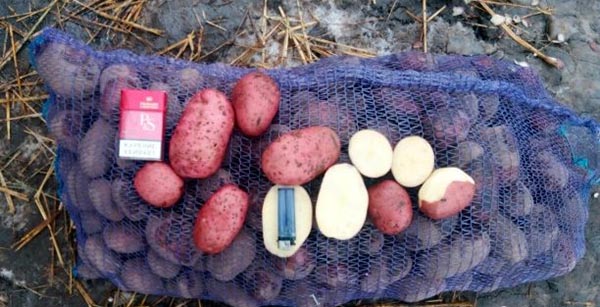
The taste is good and excellent. Culinary type AB. The pulp is weakly boiled and does not darken during the cooking process. Suitable for most types of food.
Characteristics of the Manifest variety:
- ripening period - medium early (80-90 days), but according to other sources, medium late (90-110 days);
- the shape of the tubers is oval or elongated-oval;
- the structure of the peel is smooth;
- peel color - red;
- pulp color - light yellow;
- the depth of the eyes is shallow;
- starch content - 13.0-15.4%;
- yield per one hundred square meters - 165-408 kg (maximum up to 458 kg);
- the number of tubers per bush - 11-15;
- the average weight of 1 tuber is 104-132 g;
- marketability - 79-97%;
- keeping quality - 94%.
The appearance of the plant is from medium height to high, intermediate type, semi-erect. The leaf is medium sized, open, green. The waviness of the edge is weak. The intensity of anthocyanin coloration on the inner side of the corolla is medium. The color of the inflorescences is red-purple.
Recommended for planting regions: North-West, Central, Volgo-Vyatka.
Patent holder and / or originator of the variety: RUE "Scientific and Production Center of the National Academy of Sciences of Belarus for Potato and Fruit Growing" (Belarus).
Red Scarlet
Early variety, medium yield, normal (satisfactory) taste.
Prefers to grow in soils with good air permeability. It is optimal to plant tubers with at least 5 or more eyes. The yield does not fall even during drought and high temperatures during the growing season. All tops should be removed 10 days before harvest. Tubers are formed very amicably (simultaneously).
Resistant to the causative agent of potato cancer, golden potato cyst nematode. Susceptible to late blight pathogen in tops and moderately susceptible to tubers.
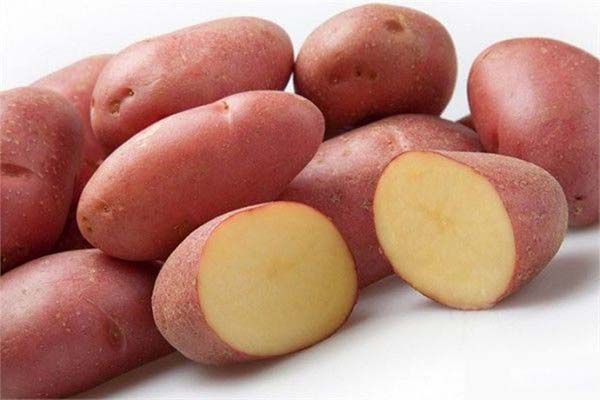
Taste properties are within normal limits (taste is satisfactory). During the cooking process, the pulp does not darken, and is also moderately (medium) boiled. Culinary type VS.Suitable for making soups, salads, as well as frying and making chips. Can be used for puree and boil.
Characteristics of the Red Scarlet variety:
- ripening period - early (70-80 days);
- the shape of the tubers is elongated-oval;
- the structure of the peel is smooth;
- peel color - red;
- the color of the pulp is yellow;
- the depth of the eyes is shallow;
- starch content - 10.1-15.6%;
- yield per hundred square meters - 164-192 kg (maximum 270 kg);
- the number of tubers per bush - up to 15;
- the average weight of 1 tuber is 56-102 g;
- marketability - 82-96%;
- keeping quality - 98%.
The appearance of the plant is low, intermediate type, semi-erect. Leaves are medium-sized, green. Inflorescences are medium in size, reddish-purple.
Recommended for planting regions: North-West, Central, Volgo-Vyatka, TsChO, West Siberian.
Patent holder or originator of the variety: HZPC Holland B.V. (Holland).
Rodriga (Rodrigo)
Medium early variety, good yield, excellent taste.
Note! To obtain friendly shoots, seed tubers are recommended to germinate before planting.
It is resistant to the causative agent of potato cancer and golden potato cyst nematode. Also, the variety is immune (resistant) to high temperatures and drought.
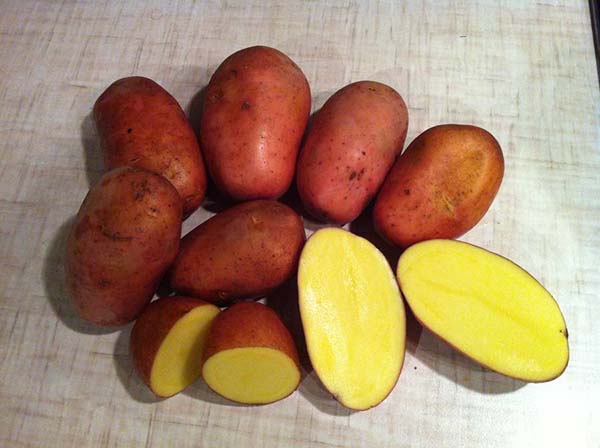
Above average to excellent palatability. Suitable for frying, first courses and salads, and for making mashed potatoes.
Characteristics of the Rodriga variety:
- ripening period - medium early (80-90 days);
- tubers are oval;
- skin structure - smooth to medium;
- peel color - red;
- pulp color - light yellow;
- the depth of the eyes is shallow;
- starch content - 12.5-15.4%;
- yield per hundred square meters - 150-218 kg (maximum up to 382 kg);
- the number of tubers per bush - 7-9;
- the average weight of 1 tuber is 85-147;
- marketability - 85-96%;
- keeping quality - 95%.
The appearance of the bushes is of medium height to high, intermediate type, semi-erect. Medium-sized leaf, intermediate, green to dark green. The waviness of the edge is medium. Inflorescences are medium in size, reddish-purple.
Recommended for planting regions: Central, Volgo-Vyatka, North Caucasian, Middle Volga, Far East.
Patent holder and / or originator of the variety: Solana GmbH & Co.KG (Germany).
Rosara
Early variety, high yielding, good taste.
Regardless of climatic conditions, it is able to give a stable harvest. Not damaged during transportation. It is characterized by amicable ripening of tubers.
When grown, responds well to watering, fertilization.
Resistant to cancer and potato nematode, slightly affected by late blight and common scab.
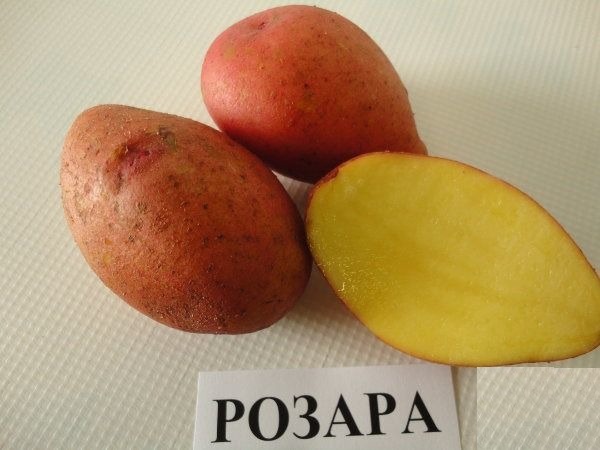
Taste good or great. During the cooking process, it hardly boils down, so the variety is ideal for soups, salads, frying, cooking French fries, chips. Not very suitable for mashed potatoes and cooking.
Characteristics of the Rosara variety:
- ripening period - early (70-80 days);
- tubers are oblong-oval;
- peel color - red;
- the color of the pulp is yellow;
- the depth of the eyes is shallow;
- starch content - 12.1-15.8%;
- yield per one hundred square meters - 202-310 kg (maximum up to 415 kg);
- the number of tubers per bush - 15-20;
- the average weight of 1 tuber is 81-115 g;
- marketability - 91-99%;
- keeping quality - 97% (good).
The appearance of the plant is a bush of medium height, semi-spreading. The flowers are red-purple.
Recommended for planting regions: North-West, Volgo-Vyatka, TsChO, North Caucasus, Middle Volga, Ural, West Siberian, East Siberian, Far East.
Patent holder and / or originator of the variety: SaKa Pflanzenzucht Gbr (Germany).
Roco (Rocco)
Mid-season variety, medium yield, good taste.
Differs in yield stability even under the most unfavorable conditions. Rocco prefers loamy, sandy or soddy soil with neutral acidity.
It is resistant to the causative agent of potato cancer and golden potato cyst nematode. Moderately resistant to late blight in tubers and moderately susceptible to tops.Resistant to wrinkled and striped mosaics.
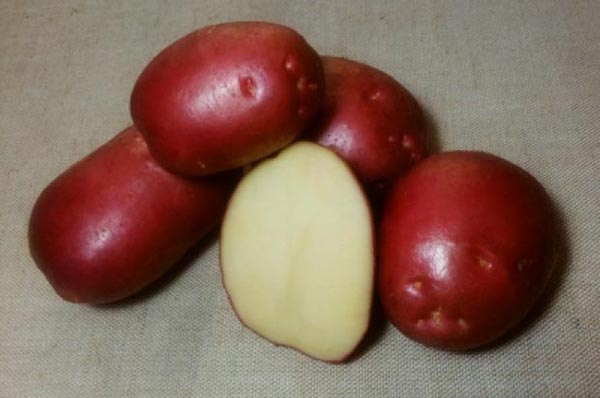
The pulp tastes good to excellent. Does not boil over during cooking. Suitable for processing into crispy potatoes, i.e. for making chips and fries. And also for salads, soups and frying.
Characteristics of the Roco variety:
- ripening period - mid-season (90-110 days);
- tubers are oval;
- the structure of the peel is smooth;
- peel color - red;
- pulp color - cream (white);
- the depth of the eyes is shallow;
- starch content - 12.9-14.5%;
- yield per hundred square meters - 136-261 kg (maximum up to 275 kg); 0
- the number of tubers per bush - 8-12;
- the average weight of 1 tuber is 75-119 g;
- marketability - 84-96%;
- keeping quality - 89%.
The appearance of the plant is of medium height, intermediate type, semi-erect. The leaf is medium sized, open, green. The waviness of the edge is medium. The flowers are large, reddish-purple.
Recommended for planting regions: Volgo-Vyatka, Srednevolzhsky, West Siberian.
Patent holder and / or originator of the variety: Niederosterreicische Saatbaugenossenschaft (Austria).
Ryabinushka
Medium early variety, high yield, good taste.
The variety easily adapts to agro-climatic conditions, has a high heat and drought resistance. It responds well to watering and timely application of fertilizers. It is recommended to germinate the tubers before planting.
It is highly resistant to damage by the Colorado potato beetle. The variety is resistant to mechanical damage. Resistant to the causative agent of potato cancer and nematodes. Moderately susceptible to tops and moderately resistant to tubers to the causative agent of late blight.
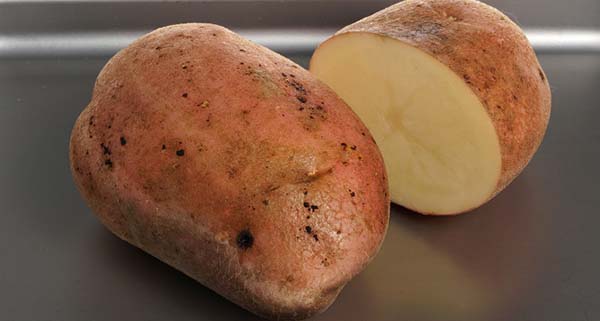
The taste is good. Culinary type B. The boil-off is weak. The pulp does not darken during cooking. Suitable for soups, salads and frying.
Characteristics of the Ryabinushka variety:
- ripening period - medium early (80-90 days);
- tubers are oval;
- the structure of the peel is smooth;
- peel color - red;
- pulp color - white (cream);
- the depth of the eyes is shallow;
- starch content - 11.9-15%;
- yield per one hundred square meters - 220-234 kg (maximum up to 396 kg);
- the number of tubers per bush - 15-18;
- the average weight of 1 tuber is 91-133 g;
- marketability - 86-96%;
- keeping quality - 90%.
The appearance of the plant is medium or tall, semi-erect. Medium or large leaves are dark green in color, and the inflorescences are purple-blue. Berry formation is absent.
Recommended for planting regions: North, North-West, Central, Volgo-Vyatka, Central Black Earth region, North Caucasian, Middle Volga, West Siberian, Far East.
Patent holder and / or originator of the variety: LLC Vsevolozhskaya breeding station (Russia).
Svitanok Kiev
Medium early variety, high yield, excellent taste.
It adapts to any type of soil, resistant to the Colorado potato beetle.
Resistant to potato cancer and rhizoctonia. Medium resistant to mosaic viruses, common scab, black leg. Moderately susceptible to late blight. Susceptible to nematode and leaf roll virus.
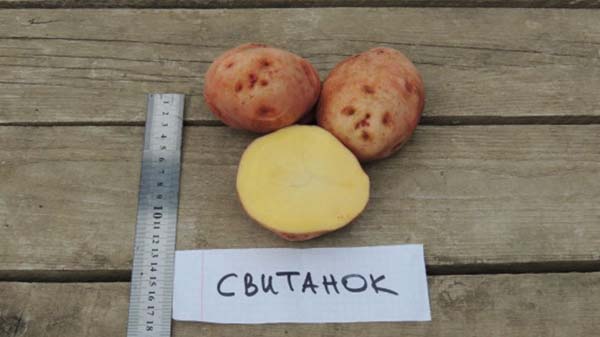
The taste is excellent. It boils well, great for making mashed potatoes.
Characteristics of the Svitanok Kievsky variety:
- ripening period - medium early (80-90 days);
- the shape of the tubers is round;
- the structure of the peel is smooth;
- peel color - pink;
- pulp color - cream;
- the depth of the eyes is shallow;
- starch content - 16-19%;
- yield per hundred square meters - up to 460 kg;
- number of tubers per bush - 8-12
- the average weight of 1 tuber is 100-130 g;
- marketability is good;
- keeping quality - 95% (good).
The appearance of the plant is low, erect. Inflorescences are light red-violet.
Recommended for planting regions: North-West, Central, Middle Volga, Ural, West Siberian, Far East.
Patent holder and / or originator of the variety: Institute of Potato Growing UAAS (Ukraine).
Other red varieties
All other varieties of potatoes with pink or red skin (alphabetically): Axona, Alvara, Amur, Arosa, Asteriks, Bashkir, Bezenchuksky, Borus, Bravo, Bryansk red,Reliable Bryansk, Visa, Gloria, Desiree, Dolphin, Detskoselsky, Evgenia, Ermak improved, Peter's riddle, Zdabytak, Ilyinsky, Ipatovsky, Irbitsky, Canberra, Kislovodsky, Kolpashevsky, Condor, Beauty, Handsome, Red Rose, Kuzn, Kuzn Lazarus, Lady Blanca, Lady Rosetta, League, Manitou, Robin, Mother, Lighthouse, Mozart, Mustang, Nakra, Nart 1, Ognivo, Odysseus, Oleva, Olympus, Joy, Patriot, Povin, Flight, Radonezhsky, Red Anna, Red Lady , Red Sonya, Red fantasy, Rosalind, Rosanna, Romano, Romance, Russian beauty, Samara, Sarovsky, Serpanok, Symphony, Lilac fog, Slavyanka, Bullfinch, Sokolsky, Sotochka, Spiridon, Tarasov, Tomich, Tulunsky early, Early morning, Favorite , Khibiny early, Kholmogorsky, Sheri, Evolution, Yubilyar, Yakutyanka.
Potato varieties with red or pink eyes: top 5
It should be said right away that there are only a few varieties of potatoes with pink or red eyes (about 10), but you can also choose the 5 most delicious and / or fruitful ones from them. However, the most unusual and popular is only one (you will find out later).
Important! Have Zhukovsky earlyas in Svitanka of Kiev not only red peel, but also red eyes.
Aurora
Mid-season variety, high-yielding, excellent taste.
The variety is able to adapt to any climatic growing conditions, and is also not picky about the type of soil.
Resistant to potato crayfish and nematodes, moderately resistant to viruses, moderately susceptible to the causative agent of late blight in the tops and tubers.
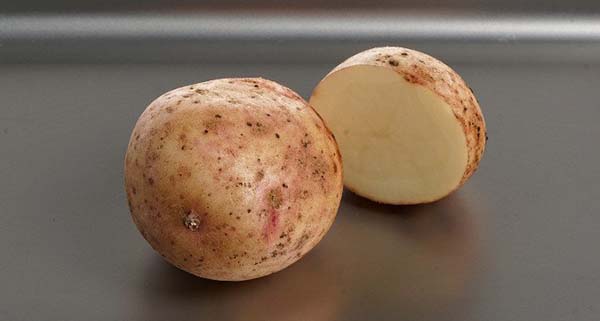
The taste is excellent. When cooked, the potatoes become crumbly (medium boiling). Culinary type VS. Suitable for mashed potatoes, roasting, soups and salads.
Characteristics of the Aurora variety:
- ripening period - mid-season (90-110 days);
- the shape of the tubers is oval (aligned);
- the structure of the peel is smooth;
- peel color - yellow with red eyes;
- pulp color - white (cream);
- the depth of the eyes is shallow;
- starch content - 13.5-17.3%;
- yield per hundred square meters - 214-396 kg (maximum up to 416 kg);
- the number of tubers per bush - from 20-25;
- the average weight of 1 tuber is 93-128 g;
- marketability - 80-93%;
- keeping quality - 94%.
In appearance, it is distinguished by tall bushes with large foliage of a light green hue. The inflorescences have a red-purple hue. Berry formation is average.
Recommended for planting regions: North, North-West, Central, Volgo-Vyatka, TsChO, North Caucasian, Middle Volga, East Siberian, Far East.
Patent holder or originator of the variety: Vsevolozhskaya breeding station LLC (Russia).
Picasso (Limonka)
Important! Most likely (99%), if you were looking for a variety with red eyes, then this is it.
Late variety, good yield and satisfactory taste.
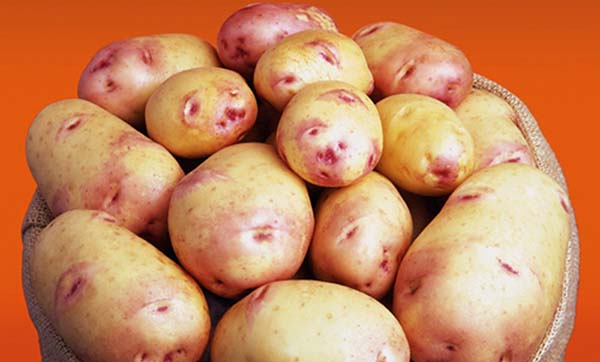
Interesting! The variety is named after the artist due to the yellow-pink color of the peel. In Russia, it received a popular name - Limonka potato.
For successful cultivation, preliminary germination of the planting material is recommended, as well as increased fertilization. Picasso is resistant to drought and high temperatures during the growing season.
Resistant to cancer and potato nematode, susceptible to late blight, moderately affected by leaf twisting and common scab. The variety tolerates transportation very well.
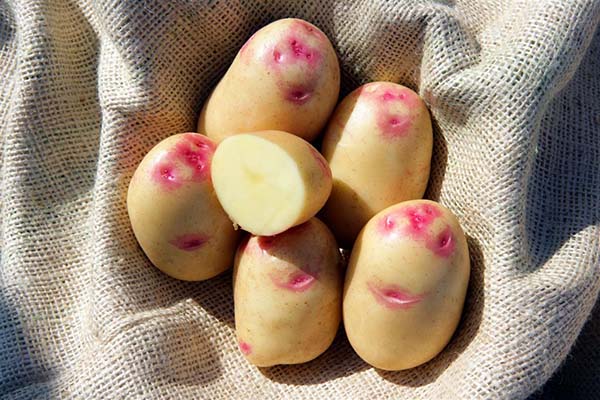
The taste is satisfactory and good. The pulp does not boil during cooking, so it is recommended to use it for frying, making soups and salads.
Characteristics of the Picasso variety:
- ripening period - late (120-140 days);
- the shape of the tubers is oval-round;
- the structure of the peel is smooth;
- peel color - yellow with pink eyes;
- pulp color - cream;
- the depth of the eyes is shallow;
- starch content - 7.9-13.5%;
- yield per hundred square meters - 193-315 kg (maximum up to 321 kg);
- the number of tubers per bush - up to 19;
- the average weight of 1 tuber is 75-126 g;
- marketability - 79-94.1%;
- keeping quality - 83-90%.
Recommended for planting regions: Central, TsCHO.
Patent holder and / or originator of the variety: Agrico U.A. (Holland).
Nevsky
Medium early variety, high yield and average (satisfactory) taste.
By the way! According to some sources, the most popular potato variety in Russia.
Suitable for all regions. Nevsky gives good results when grown on sandy loam and loamy soils with a deep arable layer. Resistant to drought and waterlogging.
Important! When planting, it requires preliminary heating of the seed (you can not plant it directly into cold soil), it is sensitive to the breaking off of sprouts. Responds well to plentiful feeding. To avoid scab damage, requires moist soil at the time of tuber formation.
Resistant to the causative agent of potato cancer, rhizoctonia, potato viruses. Moderately resistant to common scab. Moderately susceptible to late blight in tops and tubers. Resistant to mechanical damage. However, tubers tend to germinate during long-term storage.
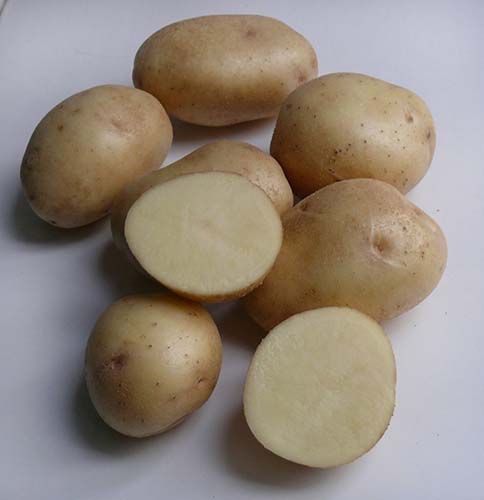
The taste is satisfactory or good. Culinary type VS. The digestibility is poor. The pulp does not darken during the cooking process. This means that Nevsky is suitable for preparing first (soups) and second courses (salads), but due to the low starch content, it is not very suitable for mashed potatoes, but very suitable for frying.
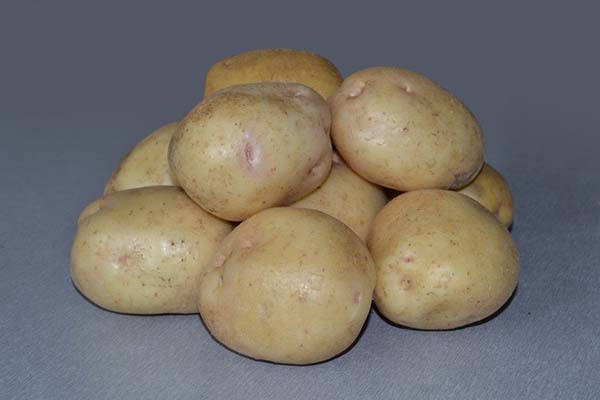
Characteristics of the Nevsky variety:
- ripening period - medium early (80-90 days);
- the shape of the tubers is oval, aligned;
- the structure of the peel is smooth or mesh;
- peel color - light beige with pinkish eyes;
- the color of the pulp is white;
- the depth of the eyes is shallow;
- starch content - 10-12%;
- yield per hundred square meters - 380-500 kg;
- the number of tubers per bush - 17-20;
- the average weight of 1 tuber is 90-130 g;
- marketability - 90-95%;
- keeping quality is good.
The appearance of the plant is semi-erect, intermediate type, of medium height. The leaf is medium, light green, the edge waviness is weak. The flowers are white. Berry formation is average.
Recommended regions for planting: absolutely all regions.
Patent holder and / or originator of the variety: Federal State Budgetary Scientific Institution "Leningrad Scientific Research Institute of Agriculture" Belogorka "(Russia).
Other varieties with pink or red eyes
Other varieties of potatoes with pink or red eyes: Bonnie, Bryanskaya novinka, Vektar Belorussky, Snegir.
By the way! There is a variety Sineglazka with purple (dark blue) eyes, which is often sold on the market with red eyes and red spots, as if it were Sineglazka. However, these are completely different varieties.
Sineglazka (Hannibal)
Mid-season variety, high yield, excellent taste.
A variety of folk selection. Cannot be found in the official sale.
Relatively resistant to late blight, common scab.
The variety is not picky about care. It prefers to grow in light sandy soil with a low acidity index, otherwise the yield is significantly reduced.
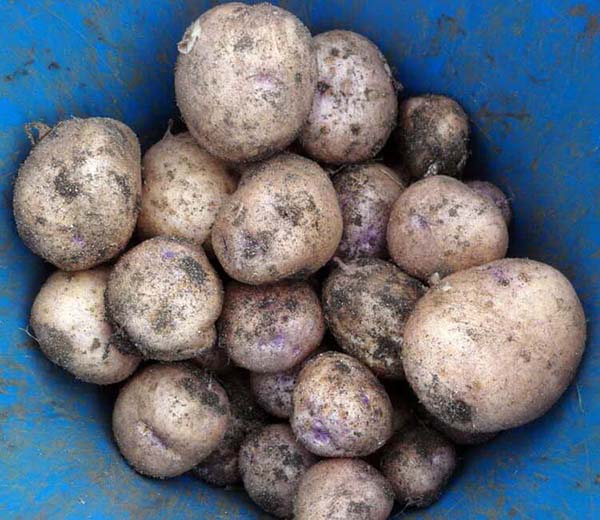
The taste is excellent; the pulp is slightly boiled during cooking. Recommended for any kind of food, especially puree.
Characteristics of the Sineglazka variety (unofficial):
- ripening period - mid-season (90-110 days);
- tubers are oval-oblong;
- the structure of the peel is mesh;
- peel color - cream with dark blue (purple) eyes;
- the color of the pulp is white;
- the depth of the eyes is shallow;
- starch content - 15-17%;
- yield per hundred square meters - up to 500 kg;
- the number of tubers per bush - 8-12;
- the average weight of 1 tuber is 70-130 g;
- marketability - unknown;
- keeping quality is low.
The appearance of the plant is strong tall bushes with densely leafy shoots. Leaves of medium size, dark green. Inflorescences are light lilac with a bright yellow core.
Recommended for planting regions (presumably): Central.
Patent holder and / or originator of the variety: did not undergo official agrotechnical tests on the territory of the Russian Federation, and, accordingly, is not included in the State Register.
You received the information. Now you just have to compare the advantages and disadvantages of red varieties and choose the most suitable one in terms of characteristics and growing conditions (if you are going to plant in your garden).

